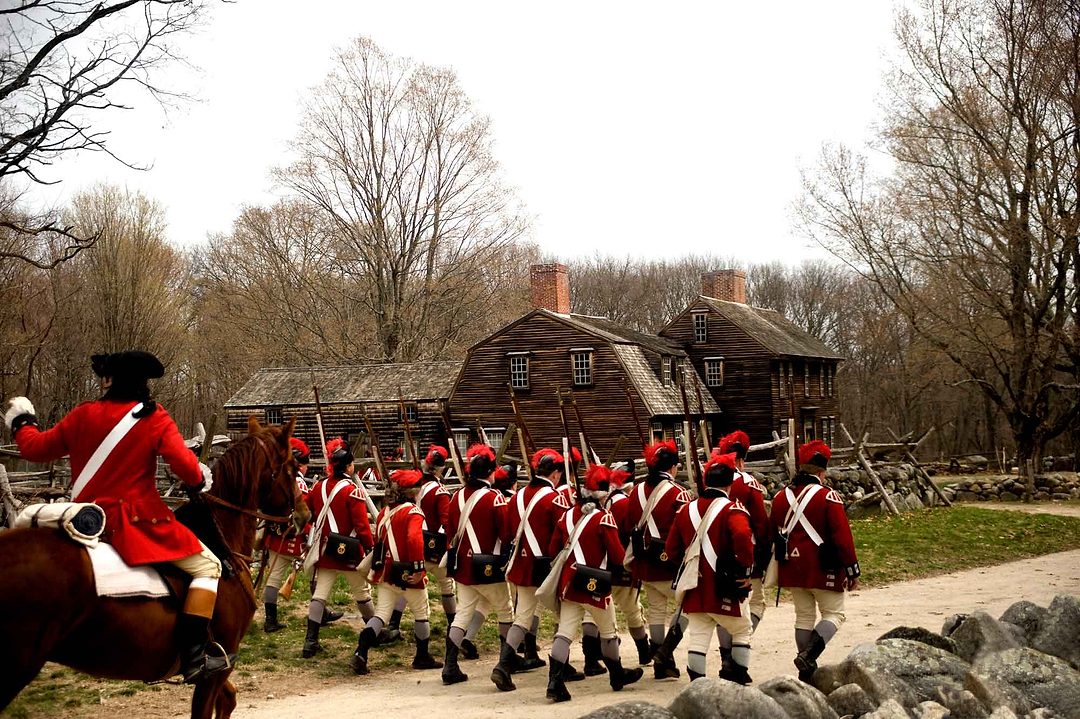Imagine regiments of heavily armed men marching past your front door with grim determination—almost 800 of them, half the population of Concord in 1775. That was the scene that greeted the residents of the town on the morning of April 19th of that year.
If you weren’t one of the well-trained Minutemen loading your musket at the North Bridge, what was it like to be in Concord on the morning of that historic day?
If you were Concord’s patriot preacher, Rev. William Emerson,* you would have been up since the wee hours, when Samuel Prescott woke the town to warn of the approaching Redcoats. Emerson hurried to the ridge overlooking the Bay Road (now Lexington Road) and urged the outnumbered Minutemen to launch a pre-emptive strike, which they prudently didn’t do. When he returned to the parsonage (now preserved as the Old Manse), a crowd of the town’s women and children turned up at his door seeking refuge. Rev. Emerson welcomed the terrified townspeople with open arms, and even offered them an alfresco breakfast.
Later that morning, his wife Phebe Bliss Emerson would witness the importance of that day, as the Redcoats exchanged deadly fire with the colonists in her back yard. Many historians believe that her husband stood shoulder to shoulder with the Minutemen at the North Bridge as Phebe watched from a window of the Old Manse, surrounded by her children, including 8-month-old Mary Moody Emerson and 5-year-old William (whose son, Ralph Waldo Emerson, would later immortalize that moment as “the shot heard ’round the world”).

The Battle of Concord April 19, 1775
| Shutterstock.com/Everett CollectionIf you were in the militia, you might have been sent somewhere other than the North Bridge. The town’s leaders dispatched saddle maker Reuben Brown to ride to Lexington and verify the report of an approaching British force. Brown arrived there at daybreak, just as two companies of Redcoats advanced toward the Lexington militia guarding the town common. He rode back to Concord in haste, too soon to witness the volley that killed eight Lexington men and wounded ten more. When Major Buttrick asked him if the British soldiers were firing live ammunition, he could only reply “I do not know, but think it probable.”
Reuben Brown’s work wasn’t done, though. He reportedly rode 100 miles that day, spreading the alarm to towns as far away as Hopkinton. He came home to find his house on the Bay Road had been looted by the retreating Redcoats, who took saddles, cartridge boxes, and a carriage to transport their wounded comrades. They set fire to his barn, too, but the fire was extinguished before it did much damage.
If you were hiding weapons, you might try to guard them from the Redcoats. Ephraim Jones was a versatile fellow who was the town’s jailer and also kept an inn, conveniently located next door to the jail. He had hidden three cannons in the jail yard, and when British Major John Pitcairn tried to search his premises, Jones blocked his way. Pitcairn knocked him down, swearing at him all the while, and his men took the cannons, but they missed another treasure, thanks to Hannah Barnes, a server at Jones’ tavern. Henry Gardner, the treasurer of the Provincial Congress, was storing a chest of money and important papers at the tavern, and Barnes kept the Redcoats out of Gardner’s room by insisting that the room was her own.

Rev. Dana McLean Greeley of First Parish Church with communion silver
| Courtesy Concord Free Public LibraryAfter his scuffle with Jones, Major Pitcairn adjourned to the Wright Tavern, where he made his famous remark about wanting to “stir the damned Yankee blood.” What Pitcairn didn’t know was that the First Parish communion silver was probably hidden right under his nose, where it had been concealed in a barrel of soap as a precaution against looting. The retreating Redcoats did raid the Meetinghouse, but succeeded in stealing only a two-volume Bible.
Like Hannah Barnes, the wife of patriot Amos Wood appealed to the British soldiers’ sense of propriety to conceal military stores in her house by the South Bridge. An officer pointed to a closed door and asked if there were “some females” in there. Mrs. Wood sternly declared, “I forbid anyone entering this room!”
Col. James Barrett had stored a quantity of weapons and ammunition at his farm (preserved by the National Park Service on present-day Barrett’s Mill Road), including a real prize—two pair of bronze cannons. Barrett’s sons had buried the cannons in the freshly-plowed fields, and their mother, Rebecca Hubbard Barrett, had hidden the rest in casks and covered them over with feathers. The Regulars came to the door, announcing “Our orders are to search your house . . . from top to bottom,” but they found nothing except some gun carriages. They asked for food and drink, which Mrs. Barrett graciously provided, and refused their offer of money, saying “We are commanded to feed our enemies.” They threw a handful of coins at her, and she sneered, “This is the price of blood.”
Or if you were Martha Moulton, you might have turned out to be the most heroic noncombatant of the day. Described as “an aged widow,” she worked as a housekeeper for Dr. Timothy Minot, whose house overlooked the town’s Liberty Pole (near the present-day roundabout in Monument Square). The Redcoats “made a bonfire of the town’s Liberty Pole. The fire spread to the roof of the nearby courthouse,” and Mrs. Moulton ran into the street to implore the soldiers to put out the fire. They waved her away, saying “O mother, we won’t do you any harm!” She finally got their attention by shouting, “The top of the house is filled with powder, and if you do not put the fire out, you will all be killed.” They extinguished the fire, and the town was saved.
The Minuteman’s victory at the North Bridge was the most visible part of a coordinated effort that depended on the support of their neighbors and families, who share in the victory they won 245 years ago.
*Read more about Rev. Emerson in the Winter 2019 issue of Discover Concord.
Principal Sources: David Hackett Fischer, Paul Revere’s Ride, 1994; Robert Gross, The Minutemen and Their World, 1976; Lemuel Shattuck, History of Concord, 1835; Ruth R. Wheeler, Concord: Climate for Freedom, 1967


